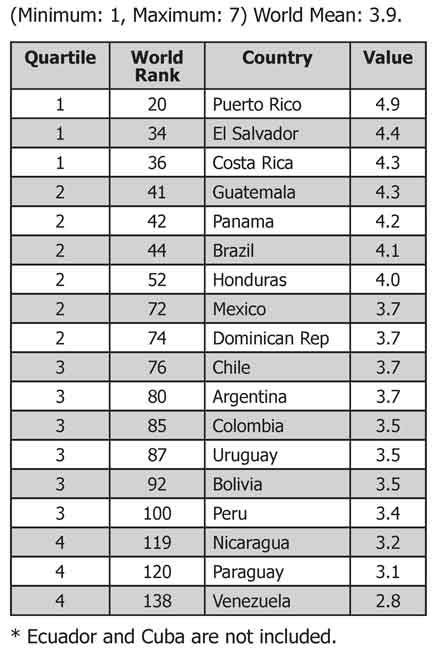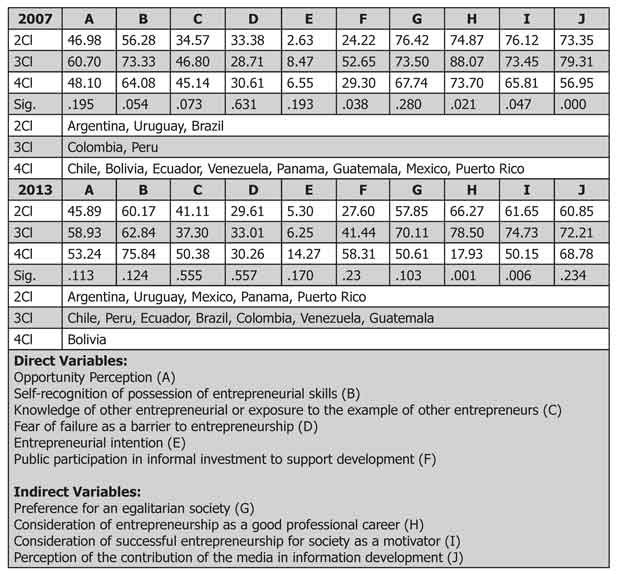1. Introduction
The use of Information and Communication Technologies (ICTs) has changed the relationship between firms and consumers, resulting in new marketing policies focused on real-time consumers' needs that can be satisfied through marketing. In this sense, Parsons, Zeisser and Waitman (1998) describe new forms of interaction rooted in the IT-enabled interactivity between prospective clients and ICT-based firms for further product customization. The advent of the Internet and e-mail has provoked both the rise of a type of marketing based on clients' permission (Godin & Peppers, 1999), and the maximal exploitation of limited financial resources, as typical in the first entrepreneurial stages, what is redefined by competition rules, as summarized in the term radical marketing.
Entrepreneurs must be focused on a customer-centric marketing defined by the accomplishment of the needs of individual customers. As a result, entrepreneurs must be focused on the needs, wants and resources of customers, as the starting point directed to planning and conceiving consumer-focused strategies (Sheth, Sisodia, & Sharma, 2000).
Given these premises, academic research using the Global Entrepreneurship Monitor (GEM) project database over the last fifteen years shows entrepreneurship as a phenomenon formed by interacting endogenous variables -e.g., formal and informal education, previous working experience, values, capital tenure-, and exogenous variables -e.g., public administration aid, external shocks, natural disasters-. The stage of countries' development explains a substantial fraction of the Total Entrepreneurial Activity (TEA) rate, classified as High Growth Potential TEA, Necessity TEA, Opportunity TEA, and Overall TEA, as it rapidly decreases while paid employment grows in the transition of societies towards innovation-driven economies (Figure 1). Developed countries with a Gross Domestic Product (GDP) per capita higher than USD 20,000 in terms of Purchasing Power Parity (PPP) are mainly innovation-driven economies-Phase 3-, defined by R&D and innovation, while startups in emerging countries are mainly factor-driven nations -Phase 1-, where human resources have a key role to play. While countries develop, the TEA diminishes, as these startups begin to grow in size, but not in number. In this case, countries are efficiency-driven economies -Phase 2- where productivity, optimal use of resources, experience, and formation are crucial for businesses, mainly Small and Medium Enterprises (SMEs), to survive in a competitive world. In this process, however, there is a cost in terms of loss of entrepreneurial values in the population. Not only the TEA diminishes, but also other indicators of the general entrepreneurial activity of the population.
Globalization and the economic crisis are altering this process in ways that are important to analyze. The countries most affected by the economic crisis have yielded lower TEA. This is because higher TEA in some countries has not reduced their unemployment rates, since entrepreneurial activity has actually decreased as a result of market rigidity, lack of funding due to a precarious economic context, and the weakening of cultural and entrepreneurial values. This last element leads us to the following question: Does the economic crisis necessarily lead to the loss of the entrepreneurial values in a society?
A relevant research to answer the above mentioned question has been carried out, as we will see in the literature review of the psychological characteristics of the entrepreneur, which has barely investigated on the relationship between economic development and changing values in entrepreneurship, thus justifying our research. Entrepreneurial values are linked to a higher capacity for innovation. As a result, and related to this higher business capacity for innovation, some Latin American countries situated in the first quartile (Puerto Rico, El Salvador, and Costa Rica), despite their structural economic problems, are in the midst of a transition to higher stages of development and competitiveness, as revealed by the Global Competitiveness Index, while those situated in the fourth quartile -Nicaragua, Paraguay, and Venezuela- are still at some distance from that goal (Table 1).
The aim of this paper is, given business strategies mainly rooted on digital marketing thanks to ICTs, to define a psychological profile of the entrepreneurial activity in the Latin American countries that participate regularly in the GEM project. To do this, the structure of the document is as follows: first, we compare the entrepreneurial activity using three components: [1] The prevalence of entrepreneurial traits in GEM Latin American countries; [2] Their entrepreneurial activity, and [3] The kind of entrepreneurial activities that have been developed. Second, we analyze how the first part of the 2007-2018 World economic cycle defined by the First Global Financial Crisis (FGFC) (Reinhart, 2008; Letica, 2010), although the economic crisis in Latin America was especially intense, it was only until 2009 that it started with a rapid recovery, and as a result, it is more a slowdown than an economic crisis.
The reason for choosing the years 2007 and 2013 is because both are situated in the first half of the 2007-2018 World economic cycle. Hence, we propose to test the following hypothesis:
H1: decreasing economic development is reducing the prevalence of entrepreneurial values in GEM Latin American countries.
H2: decreasing economic development is reducing the entrepreneurial activity in GEM Latin American countries.
H3: the FGFC is changing the traits of the entrepreneurial activity in GEM Latin American countries, in the sense of increasingly shifting from quantity to quality.
2. Literature Review
A major stream in academic entrepreneurship research has been focused on determining which are the key psychological characteristics in creating new businesses, taking into consideration aspects such as ambition (Sexton & Bowman-Upton, 1990), intuition (Saiz-Alvarez, Cuervo-Arango, & Coduras, 2014), capacity for endurance in adverse situations (resilience) (Sexton & Bowman-Upton, 1990), desire for responsibility (Timmons, 1999), initiative (Jennings, Cox, & Cooper, 1994), and desire to succeed (Poschke, 2013). These psychological factors foster the entrepreneurial spirit, and augment the need for power and achievement, as shown in the classical works of McClelland (1961), Hornaday and Aboud (1971), Hornaday and Bunker (1970), and Liles (1974), and more recently in Jennings, Cox and Cooper (1994), and Demiralp and Francis (2013). Since the seminal work of Collins, Moore and Unwall (1964), this need for power and achievement is complemented with the need of independence (Scheinberg & MacMillan, 1988; Salas-Fumás & Sánchez-Asin, 2013).
All these researches had been focused on developed countries, but entrepreneurs compete in a "glocalized" economic world. Applied to globalization, the term "glocal" (think global, act local) aims to promote economic development, integration and convergence among developed and developing/ emerging economies (Caravannis & von Zedtwitz, 2005). To reach this goal, the psychological values of entrepreneurs have a key role to play as "the entrepreneur shifts economic resources out of an area of lower and into an area of higher productivity and greater yield" (Drucker, 1985, p. 21) bearing risks in mind.
Especially in developing/emerging countries, the entrepreneur is an agent of change when impelling a new economic entity from ideation to functional reality (Carayannis et al., 2014). Only firms in the High Growth Potential TEA group have a significant impact on economic development (Chaston, 2010) resulting in wealth and the creation of stable and long-term employment. This fact causes social and economic structural changes while fostering economic growth and development.
In the last fifteen years, and especially since the publication of the GEM project in more than 70 countries, the relationships among entrepreneurship, innovation and culture have received quite a lot of attention (Hayton & Cacciotti, 2013; Wennberg, Pathak, & Autio, 2013; Rauch et al., 2013; Tsand & Park, 2013; Elliot & Nakata, 2013; Konrad, 2013; Nissan, Galindo & Méndez, 2012; Wang, 2010). These discussions mainly affect the entrepreneurial values held by individuals, factors that determine the entrepreneurial spirit of people and societies to which they belong. A significant portion of the literature (Huarng & Ribeiro-Soriano, 2014; Fernández-Pérez et al., 2014; Prause, Méndez & García-Agreda, 2013) attributes these values to the varying progress of entrepreneurial activity, innovation, technology (Kim & Huang, 2011), and quality. In particular, they seem to observe a general reduction in the entrepreneurial values of the population, as GDP increases. This loss of the entrepreneurial trait is one of the issues that should be resolved prior to launching entrepreneurship in areas where this activity is essential for generating employment and change towards new industrial configurations based on experience, skills, knowledge, innovation and quality.
Our comparative analysis of values and attitudes in entrepreneurship uses mainly individual indicators, and this could explain the apparent difficulty of ascribing a readily recognizable quality to the groupings obtained in our work. According to Marcotte (2011), and Lee, Peng and Song (2013), the individual approach leaves out the institutional/organizational component. In this sense, Stenholm, Acs and Wuebker (2013) show how differences in institutional arrangements influence both the rate and the type of entrepreneurial activity in a country, and suggest that differences in institutional arrangements are associated with changes in both rate and type of entrepreneurial activity across countries.
Contrary to this fact, and working with a database of 16 emerging countries, Marcotte (2014) finds that the economic and governance indicators, proxy of the institutional context of the country, impact positively on entrepreneurship, especially on the most innovative kind. Also, Simón-Moya, Revuelto-Taboada, and Guerrero (2014) identify groups of countries with similar economic and institutional environments, and study the differences between entrepreneurial activity and innovation outcomes amidst those homogeneous groups, to find significant differences, not only in the entrepreneurial activity, but also in the type of entrepreneurship and innovation results.
3. Methodology
Our study uses data that has been collected at the national aggregate level by the GEM project in Latin America for the years 2007 and 2013, as these years are situated, respectively, in the beginning and ending of the first economic cycle created by the first global crisis. The main difficulty in the selection of countries has been the inconsistent participation of some Latin American countries and, in other cases, their very recent addition to the GEM project.
These problems do not allow us to use homogeneous data in all countries; thus, we have decided to analyze, in the case of Bolivia, Ecuador, El Salvador, Mexico, Panama, and Venezuela, with data closest to 2007 and 2013, while Costa Rica and Dominican Republic are excluded, since there is no comparable data available. A description of data availability and country, as well as the final selection are shown here (Table 2).
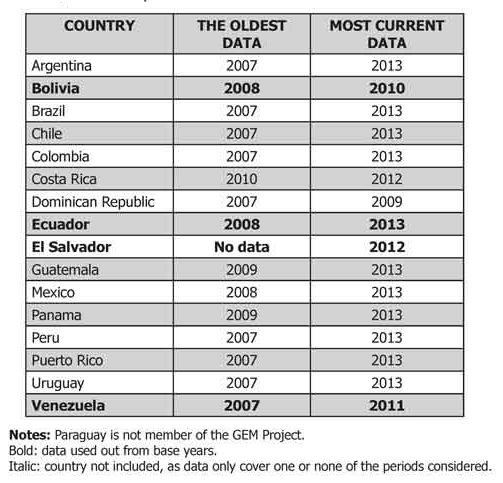
Source. Prepared by the authors based on GEM, (2013).
Table 2 Availability of Data in GEM Latin American Countries for the First-half of the FGFC World Economic Cycle.
Besides, GEM variables representing the values and attitudes of entrepreneurs, entrepreneurial activity and social aspirations are included and described in the analysis to provide economic and social value. All of them come from GEM databases at the national aggregate level. Therefore, as in Amorós and Bosma (2013), the GEM model has been followed in its current configuration.
As the main objective of this paper is to draw conclusions about the general hypothesis affirming that economic development has negative effects on entrepreneurial values in terms of entrepreneurial attitudes, entrepreneurial activity, and aspirations for entre-preneurship, six cluster analysis have been applied, three comprising 2007 data, and as many for 2013 data. This technique allows seeing, for each variable, the entrepreneurial changes that have taken place in GEM Latin American countries in this period, along with their significance and type of impact.
We have chosen the K-means method as the statistical technique selected within the family of cluster analysis to test our hypotheses, as this procedure attempts to identify relatively homogeneous groups of cases based on selected characteristics, using an algorithm that can handle a large number of cases. The algorithm requires the user to specify the number of clusters, so often several tests are needed in order to obtain the ideal number of clusters: one in which the number of clusters obtained is based on the highest number of variables that are statistically significant when variables are discriminated. When this type of analysis of data is applied, the only requirement is that all variables must be quantitative at the interval or ratio level that is considered. In our analysis, this requirement is met, as all variables are percentages of population between 18 and 64 years old. This technique provides variance in the analysis, giving useful information about the contribution of each variable to the separation of the groups. This contribution may be zero, when the significance of the F-statistic exceeds the value 0.05, or very important, when the F-statistical significance is lower.
To classify the development degree of the countries that are involved in the analysis, and using data from the World Economic Forum (2007, 2014), we use the Global Competitiveness Index (GCI) for 2007 and 2013. As it is well known, the GCI divides countries into three phases according to their GDP per capita: Innovation-driven (more than USD 17,000), Efficiency-driven (between USD 3,000 and USD 8,999), and Factor-driven (up to USD 2,000) with transition phases between them for those countries with intermediate levels of GDP per capita.
This configuration suggests three profiles of entrepreneurial activity in the area: group 1, closer to the standard of the developed countries; group 2, when keeping an intermediate level, and group 3, closer to the standards of the developing countries.
4. Analysis
Applying a cluster analysis of K-means involves deciding the number of groups, which in our work can range between 2 and 13. In 2007 only Bolivia was in the lowest stage, four countries were entering into the transition to efficiency driven phase, seven countries were in the efficiency driven stage, and only Puerto Rico was at the maximum stage. In 2013, with the exception of Venezuela, Peru and Puerto Rico, all countries increased their degree of developmental stage. Therefore, and in terms of competitiveness, we have four groups each year, which could help deciding the number of clusters under the assumption that development is significantly responsible for changes in the social setting of the enterprise (Table 3).
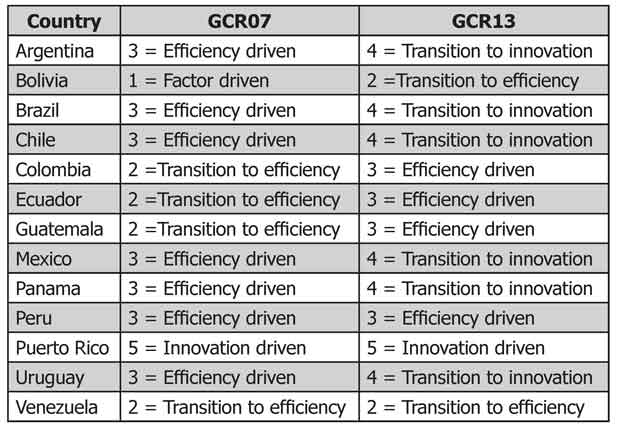
Source. Global Competitiveness Report (GCR), (2007 and 2013).
Table 3 Evolution of Latin American countries by stage of competitiveness.
To select the ideal configuration of groups of countries using K-means analysis, we have started with two sets (direct and indirect) of variables for the years 2007 and 2013 to classify GEM Latin American countries into four groups, by stage of competitiveness, using the following variables:
a) Direct
Sensing opportunity (A) Auto recognition of possession of entrepre-neurial skills (B).
Knowledge of other entrepreneurs or exposure to the example of other entrepreneurs (C).
Fear of failure as a barrier to undertake (D)
Entrepreneurial intention (E) Public participation in informal investment to support development (F).
b) Indirect
Preference for an egalitarian society (G).
Consideration of entrepreneurship as a good career (H).
Consideration of successful entrepreneurship for society as a motivator (I).
Perception of the contribution of the media in information development (J).
The significance of the variables for each analysis is shown in above (Table 4). The most discriminant configuration divides the sample into three groups (2CI, 3CL, and 4Cl) for 2007 and 2013, being the variable E significant for all groups in 2007, and variables H and I in 2013. As a result, entrepreneurial intention, entrepreneurship as a good career, and successful entrepreneurship as a social motivator were chosen as the most representative variables to analyze changes in the social profile of Latin American entrepreneurs in the dimension of entrepreneurial values and attitudes.
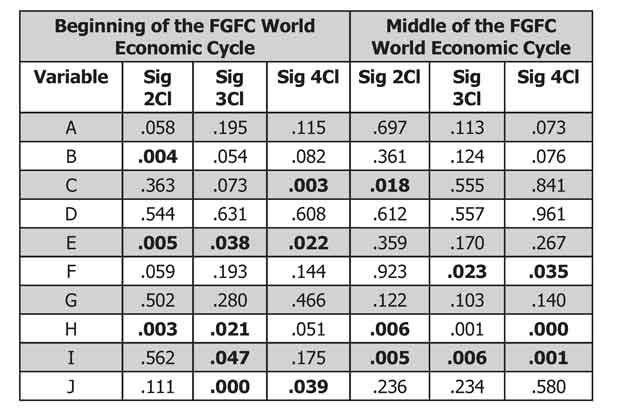
Source. Prepared by the author.
Table 4 Significance of Variables (in bold < .05) in Explanatory Cluster Analysis to Determine the Prevalence of Entrepreneurial Values and Attitudes in GEM Latin American Countries.
c) Prevalence of entrepreneurial activity in the population
The analysis is similar to the above, but it is performed on the following variables:
Participation in the process: Total Entre-preneurial Activity (TEA) rate (K)
Opportunity rate for entrepreneurship (L)
Necessity entrepreneurship rate (M)
Entrepreneurship rate in the extractive sector (N)
Entrepreneurship rate in the transformer sector (O)
Entrepreneurship in the service sector (P)
Entrepreneurship in the consumption sector (Q)
Dropout rate of business and entrepreneurial activities (R)
The results in terms of variables' significance are shown ahead (Table 5). Again, the three clusters grouping appear as the ideal setting, due to its superior discriminant capacity -highest number of significant values less than 0.05-.
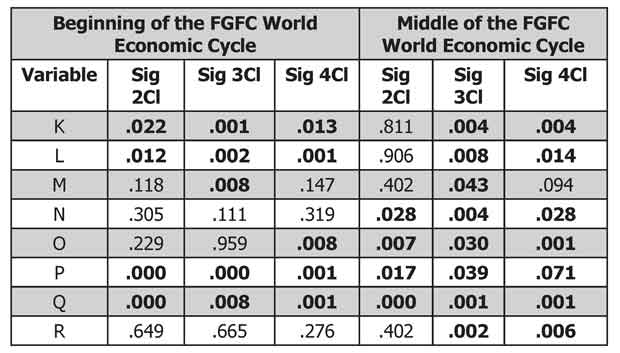
Source. Prepared by the author.
Table 5 Significance of Variables (in bold < .05) Using Explanatory Cluster Analysis to Determine the Entrepreneurial Activity in GEM Latin American Countries
Variables K, L, P and Q are significant for all clusters grouping in 2007, while variables N, O, P and Q are significant for all clusters grouping in 2013. Therefore, we chose the opportunity rate for entrepreneurship, the participation in the entrepreneurial process, and the entrepreneurship rate in the service and consumption sectors for 2007, while the entrepreneurship rate in the primary, industrial, service and consumption sectors are chosen for 2013. Moreover, only the entrepreneurship rate in the service and in the consumption sectors have not changed in terms of the prevalence of entrepreneurial activity in the population, as they have remained significant for all groups in the period.
d) Prevalence of aspirations for entrepreneurial activity in the population
Finally, we perform a similar analysis of the variables representing entrepreneurship aspirations. In this case, the set of variables is the following:
The rate of female entrepreneurship, which adds social value to promote equal gender participation in the economic sphere (S);
The rate of entrepreneurship among young people between 18 and 24 years old, which adds social value to facilitate the incorporation of young people in the labor market (T);
The rate of entrepreneurship carried out by people with higher levels of education adds entrepreneurial socioeconomic value, and expands business aspirations to create quality, innovative potential of permanence, and growth (U);
The rate of entrepreneurship of those situated in the top income bracket, which adds economic value to financial capacity (V);
The rate of entrepreneurship with aspirations for growth in its main market, which adds economic value to the region (W);
The rate of entrepreneurship with innovation [X];
The rate of competitive entrepreneurship [Y];
The rate of international orientation entrepreneurship [Z];
The rate of social value creation through employment [Omega];
The rate of technological development, which adds economic, social, and competitive value to the area, region or country, taken as the activity in technological sectors -Theta-.
Again, clustering into three clusters is the best, as this configuration has the highest number of variables with discriminatory power (Table 6). Variables S and T are significant for all clusters grouping in 2007, while variables U, V, Z and Omega are significant for all clusters grouping in 2013 (Table 7). Therefore for 2007, we choose the rate of female entrepreneurship to promote equal gender, and the rate of entrepreneurship among young people between 18 and 24 years old to add social value and to enable their incorporation into the labor market, while the rate of entrepreneurship carried out by highly educated people, the rate of entrepreneurship of those situated in the top income bracket, which adds economic value to financial capacity, the rate of international orientation of entrepreneurship, and the rate of social value creation through employment are the variables chosen for 2013. Contrary to Table 6, there is no statistically significant variable for both years, what means that the prevalence of aspirations for entrepreneurial activity in the population has changed from 2007 to 2013.
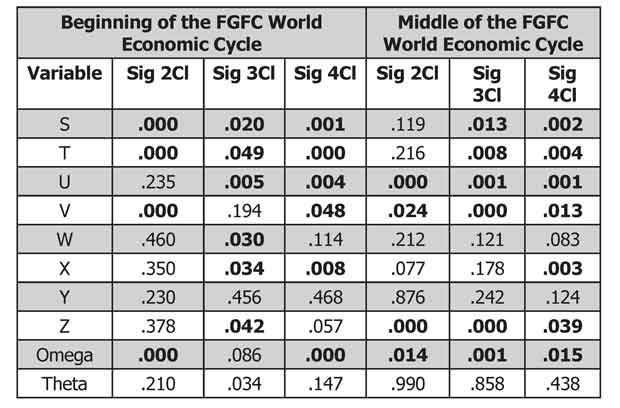
Source. Prepared by the authors.
Table 6 Significance of Variables (in bold < .05) Using Explanatory Cluster Analysis to Determine the Aspirations for Entrepreneurial Activity in GEM Latin American Countries.
5. Results and discussion
The results of the six cluster analysis performed on the three blocks of variables that characterize the social profile of entrepreneurship in Latin America are shown in this section. Each block of variables has been considered for the initial and the final year of the first half of the FGFC World Economic Cycle, 2007 and 2013 respectively, which allows us to compare these changes during these periods.
a) Prevalence of entrepreneurial values and attitudes, both direct and indirect, in the population.
In 2007 the thirteen GEM Latin American countries were very similar in terms of prevalence of entrepreneurial values and attitudes in the population. Only four factors out of ten measured in this section were capable of discriminating and classifying these countries into three groups. These factors are (Table 7):
The participation of the population in informal investments as a tool for supporting entrepreneurship (F);
The consideration of entrepreneurship as a good professional career (H);
The perception of successful entrepreneurs as social motivators (I);
The positive contribution of the media in reporting on entrepreneurship (J);
The groups of countries formed around the mean values of these variables and their developmental stages, as shown in Table 3, are:
Group 1: Argentina (3), Uruguay (3), and Brazil (3)
Group 2: Colombia (2) and Peru (3)
Group 3: Chile (3), Bolivia (1), Ecuador (2), Venezuela (2), Panama (3), Guatemala (2), Mexico (3), and Puerto Rico (5).
The second group -Colombia and Peru- is well above the others with respect to the consideration of entrepreneurship as a good professional career -88.07-, and the perception of the contribution of media in information development -79.31-. However, it resembles the first group -Argentina, Uruguay, and Brazil- in considering entrepreneurship as a motivator for success, and in thinking that the mass media is sufficiently involved in the dissemination of successful entrepreneurship.
The third group is similar to the first one, regarding the perception of entrepreneurship as a good professional career -74.87 for group 1, and 73.70 for group 2- and, in a lesser extent, concerning the participation of the population in the informal investment -29.30 for group 1, and 24.22 for group 2-.
However, this third group is relatively below compared to the other two groups in terms of successful entrepreneurship as a social motivator, and in considering the support of the mass media. Despite these differences, all countries could be considered as a block in terms of the rate of population able of perceiving opportunities, recognizing skills for entrepreneurship, and having ethical values and business attitudes.
This relatively compact social profile extends to most indicators in 2013, and the difference between countries in terms of the perception of mass media support to successful entrepreneurship disappears. However, variables F, H and I continue having discriminatory power in 2007 and 2013, but with strengthened significance what leads to a different grouping of countries with their corresponding developmental stages, as shown in Table 3:
Group 1: Argentina (4), Uruguay (4), Mexico (4), Panama (4), and Puerto Rico (5)
Group 2: Chile (4), Peru (3), Ecuador (3), Brazil (4), Colombia (3), Venezuela (2), and Guatemala (3)
Group 3: Bolivia (2)
These groups are kept ordered in terms of the growing prevalence of the population in informal investment, as it varies from 52.65 for Colombia and Peru in 2007 to 58.31 for Bolivia in 2013, with a hint to an inverse correlation between such prevalence and the level of country development. Besides, Bolivia considers entrepreneurship as a good professional career -17.93- and, more dramatically, contemplates successful entrepre-neurship as a motivating factor -50.15-. This suggests that, in less developed countries, there is a greater vision of perceiving entrepreneurship as a means of subsistence, and not necessarily as a professional development associated with higher social status.
Therefore, we cannot accept the H1 hypothesis -"Economic development is decreasing the prevalence of entrepreneurial values in GEM Latin American countries"-, as GDP growth is not producing a decrease in the prevalence of entrepreneurial values in the GEM Latin American nations as a whole. In other words, and despite their progress to higher stages of development and competitiveness, GEM Latin American societies maintain the essence of their entrepreneurial values and attitudes. The most pronounced change occurs around the competitive spirit, since in 2013, the rate of population that prefers egalitarian life is closer to 50 % than to 70 % in groups 1 and 3 (Table 7, column G).
b) Prevalence of entrepreneurial activity in the population
The sample of GEM Latin American countries analyzed in 2007 sets up a configuration in which it is possible to distinguish between three groups of countries in respect of the prevalence of entrepreneurial activity. Groups and levels of development are as follows:
Group 1: Argentina (3), Uruguay (3), and Puerto Rico (5)
Group 2: Chile (3), Brazil, (3), Ecuador (2), Venezuela (2), Panama (3), and Mexico (3)
Group 3: Bolivia (1), Peru (3), Colombia (2), and Guatemala (2)
Then (Table 8), this grouping responds to an increasing rate of total entrepreneurial activity -column K-, including the opportunity -column L-, and necessity entrepreneurship -column M-. However, they are statistically similar regarding the rate of entrepreneurship in both the extractive -column N- and transformation -column O- sectors, and in the rate of abandonment of activities -column R-. These groups are sorted descending in the rate of entrepreneurial activity in the services sector, and sorted ascending in the activity rate for the consumer-oriented sector. This configuration suggests three profiles of entrepreneurial activity in the area: group 1, closer to the standards of developed countries; group 2, keeping an intermediate level, and group 3, closer to the standards of developing countries.
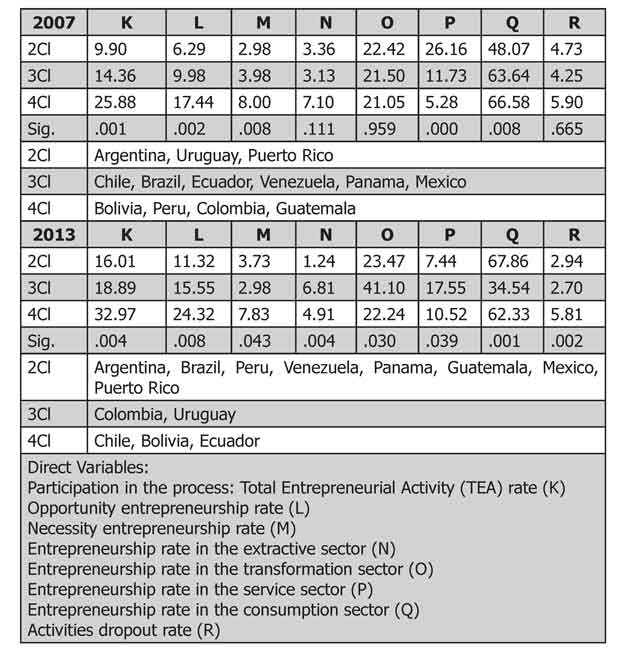
Source. Prepared by the authors.
Table 8 Prevalence of Entrepreneurial Activity in the Population for GEM Latin American Countries: Central Values of the Clusters for Each Variable and Significance (in bold, Sig. < .05)
The setting changes completely i n the year 2013, showing an upward-looking change in the economic cycle, as all entrepreneurial activity indicators have discriminating power to form three groups, as follows:
Group 1: Argentina (4), Brazil (4), Peru (3), Venezuela (2), Panama (4), Guatemala (3), Mexico (4), and Puerto Rico (5)
Group 2: Colombia (3), and Uruguay (4)
Group 3: Chile (4), Bolivia (2), and Ecuador(3)
Except for Venezuela, Peru, and Puerto Rico, the level of development in all countries increased between 2007 and 2013. Groups are now ordered in increasing rates of Total Entrepreneurial Activity (TEA). Although the group composition varies, group 3 shows the highest rate of necessity entrepreneurship -8.00 in 2007, and 7.83 in 2013-, followed by group 1 -2.98 in 2007, and 3.73 in 2013-, and group 2 -3.98 in 2007, and 2.98 in 2013-. Moreover, group 2 stands out, with respect to groups 1 and 3, in entrepreneurship in the extractive -6.81 in 2013-, in the transformative -41.10 in 2013-, and in the service -17.55 in 2013-sectors, being group 1 -67.86 in 2013-and group 3 -66.58 in 2007, and 62.33 in 2013- well above group 2 in terms of consumer-oriented entrepreneurship, while this situation is reversed in 2007 for groups 1 and 2. Finally, group 3 shows an average rate of business activities abandonment -5.81 in 2013- that almost doubles the rate reached in groups 1 and 2.
In short, average rates of entrepreneurial activity have increased between 2007 and 2013, and those of abandonment have tended to decline, especially for groups 1 and 2. This suggests that, comparing the initial and the ending years of the first half of the FGFC World Economic Cycle, the hypotheses H2 -"Economic development is reducing the entrepreneurial activity in GEM Latin American countries"- could be rejected. Therefore, entrepreneurship augments, despite the increase experienced by most countries regarding their stage of development and competitiveness, which is good if it goes in hand with an increase in the quality of entrepreneurship, which we discuss in the next section.
c) Prevalence of aspirations of entrepreneurial activity in the population
As shown (Table 9), in the beginning of the FGFC World Economic Cycle there are three groups of countries, differentiated by both their increasing rates of female -column S-, and young entrepreneurship -column T-, people with higher education -column U-, growth aspirations -column W-, innovation -column X-, internationalization -column Z-, and development in moderate or intensive technological sectors -column Theta- These groups with their corresponding developmental stages, as shown in Table 3, are:
Group 1: Argentina (3), Chile (3), Uruguay (3), and Puerto Rico (5)
Group 2: Guatemala (2), Venezuela (2), Brazil (3), Panama (3), and Mexico (3)
Group 3: Bolivia (1), Peru (3), Colombia (2), and Ecuador (2)
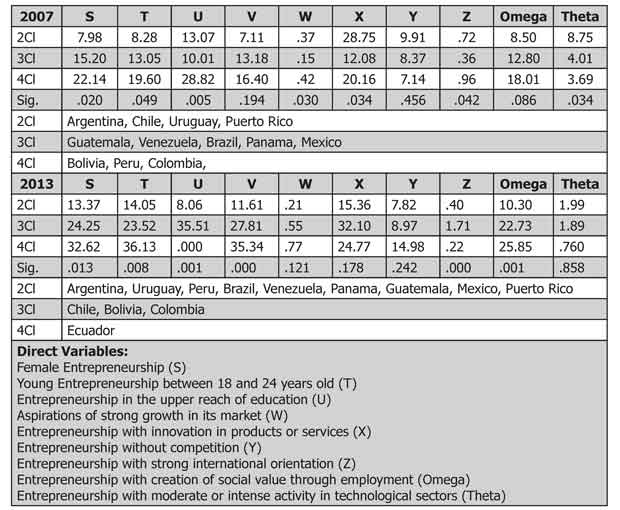
Source. Prepared by the authors.
Table 9 Entrepreneurial Values and Attitudes in GEM Latin American countries: Central Values of the Clusters for Each Variable and Significance (in bold, Sig. < .05)
These groups are ordered from low to high in the rate of female and young entrepreneurship. Group 2 shows the lowest rate of entrepreneurs with higher levels of education -10.01-. All three groups are statistically equal in the rate of entrepreneurship from the upper income bracket -column V-, in the entrepreneurship rate without competition -column Y-, and in the entrepreneurship rate with the creation of social value through employment generation -column Omega-. Group 3 shows the highest rate of entrepreneurship with a strong international orientation -0.96-, while group 1 is especially strong in product or service innovation -28.75-. Finally, all groups are sorted descending in the rate of entrepreneurial activity in the sectors of medium to high technological intensity.
In 2013, the configuration changes in some aspects: countries are statistically equal in terms of entrepreneurship with aspirations for growth -column W-, innovation -column X-, and entrepreneurship without competition -column Y-. Respecting entrepreneurship with moderate or intense activity in the technological sectors -column Theta-, is strongly moderate in all groups, although the order is kept, and is more widespread -1.99-in the group that contains the most developed countries in the area. These groups, and their corresponding developmental stages, are:
Group 1: Argentina (4), Uruguay (4), Peru (3), Brazil (4), Venezuela (2), Panama (4), Gua-temala (3), Mexico (4), and Puerto Rico (5).
Group 2: Chile (4), Bolivia (2), and Colombia (3).
Group 3: Ecuador (3).
These groups of countries are ordered from low to high in the rate of female -column S- and young entrepreneurial activity -column T-, entrepreneurship born in the upper income bracket -column V-, and entrepreneurship focused on the creation of social value through employment (column Omega). While the most developed countries in Group 1 gave increasing importance to female -13.37- and young -14.05-entrepreneurship, favoring entrepreneurs situated in the upper income bracket -11.61- in moderate or intense activity in technological sectors -1.99-, the group formed by Chile, Bolivia and Colombia focuses on internationalization, as it shows the highest rate of entrepreneurship with a strong international orientation in the region -1.71-. These results confirm, especially in the cases of Colombia and Chile, the small success of implementation of the Plan 2020 in Colombia, and the Plan Emprende in Chile. Moreover, the strong results of entrepreneurship with the creation of social value through employment -25.85- in Ecuador, also shows the very strong social orientation in terms of economic policy that has been implemented by Rafael Correa's Government in the Andean nation.
Results suggest that hypothesis H3 -"Economic development is changing the traits of entrepreneurial activity in GEM Latin American countries, in the sense of increasingly shifting from quantity to quality"- can be accepted in some aspects, but not in all of them, as although the rates of entrepreneurial activity have increased, as well as the rate of female and young entrepreneurship. In relative terms, these rates decrease as development increases, which lead us to think that these countries are far from an equal gender distribution in entrepreneurship. Besides, it is good that young people consider being an entrepreneur as an option, but they do it to a lesser extent than in the more developed countries. Finally, rates of entrepreneurship focused on job creation have also increased, but they do so only accompanied by a decrease in entrepreneurship based on innovation and technology, as well as entrepreneurship focused on internationalization in two of the groups, which is not desirable.
6. Conclusions
Although entrepreneurship is a universal phenomenon, there is very little cross-cultural research on the subject, mainly applied to Latin American countries. Contrary to both Marcotte (2014), and Simón-Moya, Revuelto-Taboada and Guerrero (2014), who use a combination of individual and institutional approaches, our results are based on following an individual approach based on GEM data for thirteen Latin American countries, which constitutes the value and originality of our paper. As a result, an existing gap in the academic research concerning this area of specialization is fulfilled.
As economic development is changing the traits of entrepreneurial activity in GEM Latin American countries, in the sense of progressively shifting from quantity to quality, digital marketing has a key role to play in order to augment sales, and consequently, their EBITDA -Earnings before Interests, Taxes, Depreciation, and Amortization- if costs are kept constant, or they are growing less than revenues. Usually, firms that are created by entrepreneurs compete globally while countries are joint in economic regions, and in this sense, digital marketing is the key for competing glocally -think global, act local- in the conceptual era.
Our results show that entrepreneurial activity, attitudes and values in these thirteen GEM Latin American nations are preserved, as these countries advance in their economic development, although it will desirable reach higher levels of entrepreneurial quality in the region, while spreading products and services into the world thanks to digital marketing. As entrepreneurial activities have increased, as well as the rate of female and young entrepreneurship, there is still some way to go for finally reaching an equal gender distribution in entrepreneurship. In this sense, we suggest that although female entrepreneurs tend to react to the same set of entrepreneurial drivers, as stated by Minniti and Nardone (2007), we show that social values determine cultural aspects of entrepreneurship in GEM Latin American countries affecting negatively gender equality.
It is positive to demonstrate that new generations consider being entrepreneurs as an option in these countries, but they do it to a lesser extent than in the more developed countries. Female and young entrepreneurship, as an individual initiative, must be completed with the support of the government to create positive externalities to be disseminated in the economy. This public policy has been recently implemented in some GEM Latin American countries with multiyear programs focused on boosting entrepreneurship and innovation.
Impelling entrepreneurship from economic policy and public programs has been made in several GEM Latin American countries. As economic development is not decreasing the prevalence of entrepreneurial values, successful entrepreneurs are socially valued in the region, and this fact can help policy makers in developing these nations, especially when the private-public collaboration is strong.
Finally, one of the limitations of our work has been the limited availability of data in some countries, so we were obliged to ignore Costa Rica and the Dominican Republic in the analysis, and to exclude Paraguay and Cuba, as they are not GEM members. We hope that, in the future, this situation will be reversed after the inclusion of these countries in the GEM Project. Our interest is to continue deepening in this topic, with the inclusion of more countries in the GEM Project in Latin America or in other regions of the world.













